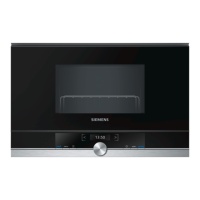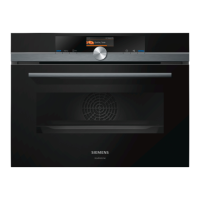How it works en
23
The contact details for Customer Service can be found
in the enclosed Customer Service directory or on our
website.
This product contains light sources from energy effi-
ciency class G. These light sources are available as a
spare part and should only be replaced by trained spe-
cialist staff.
16.1 Product number (E-Nr.) and production
number (FD)
You can find the product number (E-Nr.) and the pro-
duction number (FD) on the appliance's rating plate.
You will see the rating plate with these numbers if you
open the appliance door.
Make a note of your appliance's details and the Cus-
tomer Service telephone number to find them again
quickly.
How it works
17 How it works
Here, you can find the ideal settings for various dishes
as well as the best accessories and cookware. We
have tailored these recommendations to your appli-
ance.
17.1 What is the best way to proceed?
In this section, you will find out the best way to proceed
using step-by-step instructions to make optimal use of
the recommended settings. You will get information on
many meals, with details and tips on how to best use
and set your appliance.
Tip:Your appliance has programmed settings for a se-
lection of dishes. If you want to be guided by the appli-
ance, use the automatic programmes.
WARNING‒Risk of burns!
Foods with peel or skin may burst or explode during
heating, or even afterwards.
▶ Never cook eggs in their shell or heat hard-boiled
eggs in their shell.
▶ Never cook shellfish or crustaceans.
▶ Always prick the yolk of eggs before microwaving.
▶ The skin of foods that have a peel or skin, such as
apples, tomatoes, potatoes and sausages, may
burst. Before heating, prick the peel or skin.
ATTENTION!
Acidic food may damage the grid
▶ Do not place acidic food, such as fruit or food with
an acidic marinade directly on the pan support.
Note:Information for those allergic to nickel
In rare cases, small amounts of nickel may pass into
the food.
1.
Select a suitable dish from the overviews.
Tips
¡ If you are using the appliance for the first time,
proceed in accordance with the following basic
information:
– →"Safety", Page2
–
– →"Condensation", Page11
¡ If you do not find the exact dish or application
that you want to prepare or implement, look for a
similar dish and take the general information into
consideration.
2.
Remove any accessories from the cooking compart-
ment.
3.
Select suitable cookware and accessories.
Use the cookware and accessories listed in the re-
commended settings.
4.
Only preheat the appliance if the recipe or the re-
commended settings tell you to do so.
5.
Use the recommended settings when configuring
the appliance settings.
6.
WARNING‒Risk of scalding!
Hot steam may escape when you open the appli-
ance door. Steam may not be visible, depending on
the temperature.
▶ Open the appliance door carefully.
▶ Keep children at a safe distance.
When the dish is ready, switch off the appliance.
17.2 Defrosting, heating and cooking with
the microwave
Recommended settings for defrosting, heating and
cooking with the microwave.
The cooking time depends on the cookware, as well as
on the temperature, composition and quantity of the
food. This is why temperature ranges are given in the
tables. Begin with the lower temperature and, if neces-
sary, use a higher setting the next time. If you use dif-
ferent quantities than those specified in the table, ad-
here to the rule of thumb: Double the amount = almost
double the time, half the amount = half the time.
Tips on defrosting, heating and cooking with the
microwave
Follow these tips for good results when defrosting,
heating and cooking with the microwave.
Issue Tip
You want to prepare a dif-
ferent amount than that in-
dicated in the table.
Increase or reduce the
cooking times using the
following rule of thumb:
¡ Double the amount =
almost double the
cooking time
¡ Half the amount = half
the cooking time

